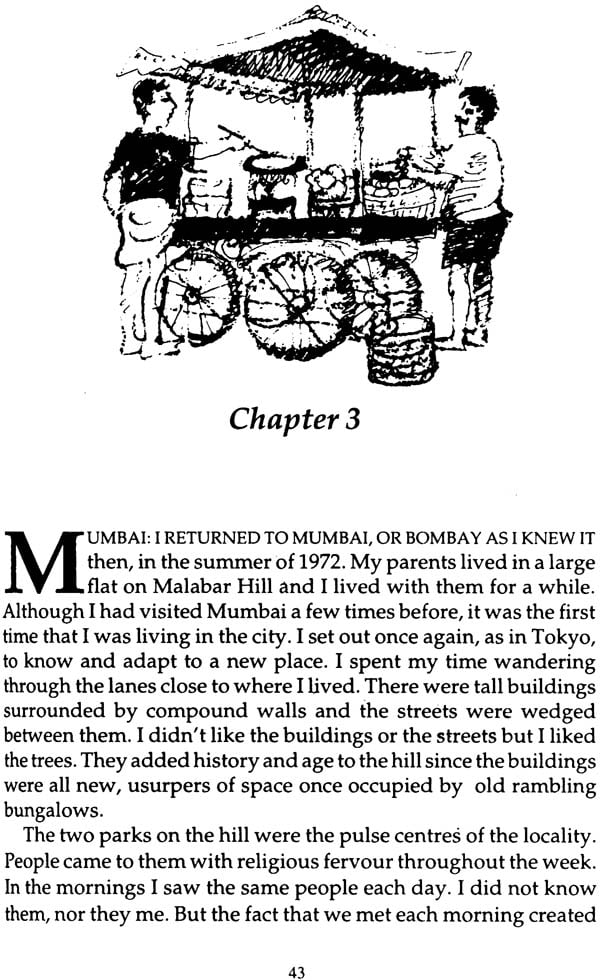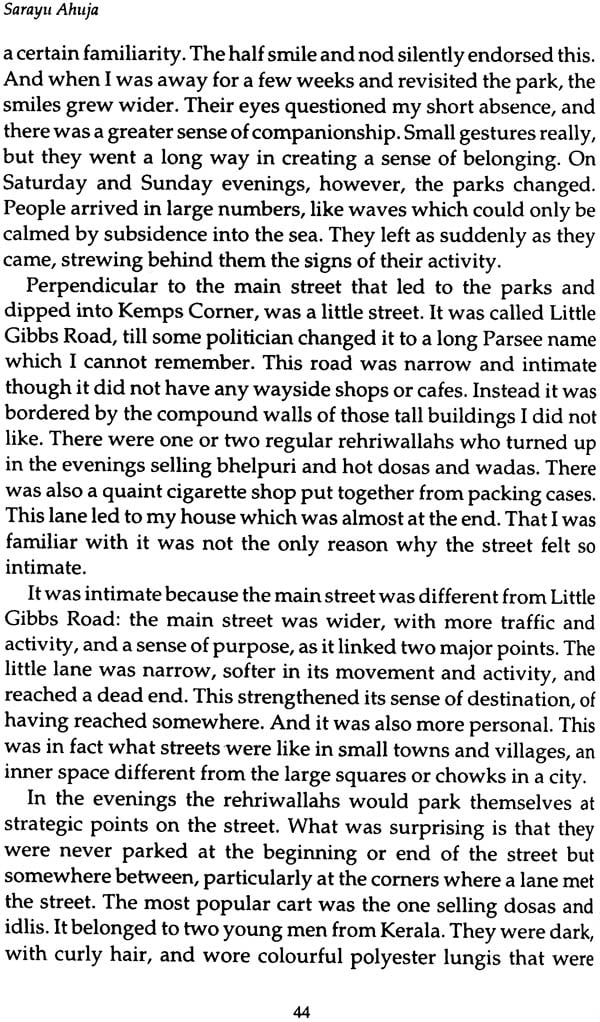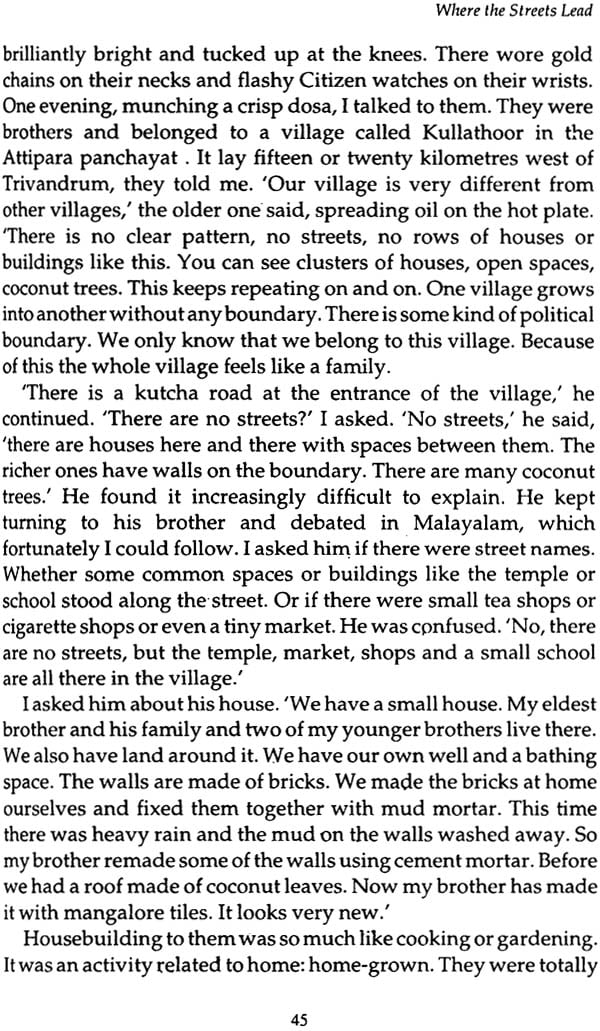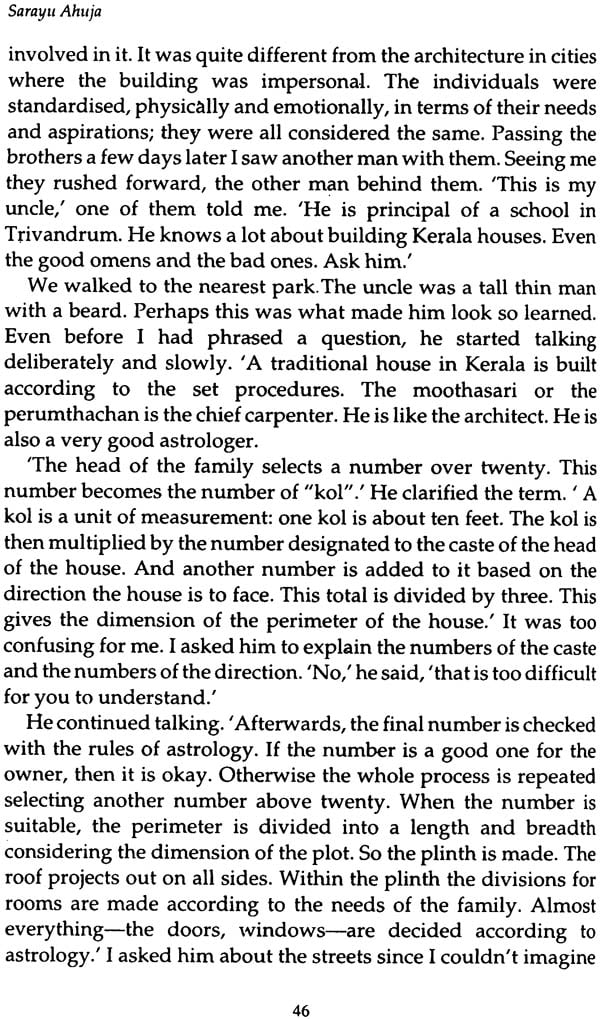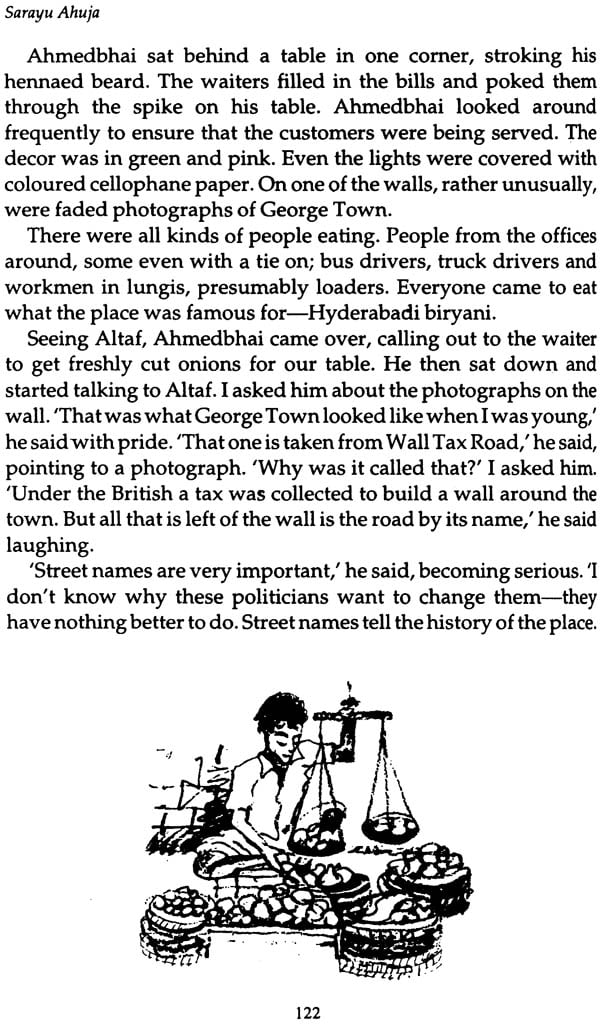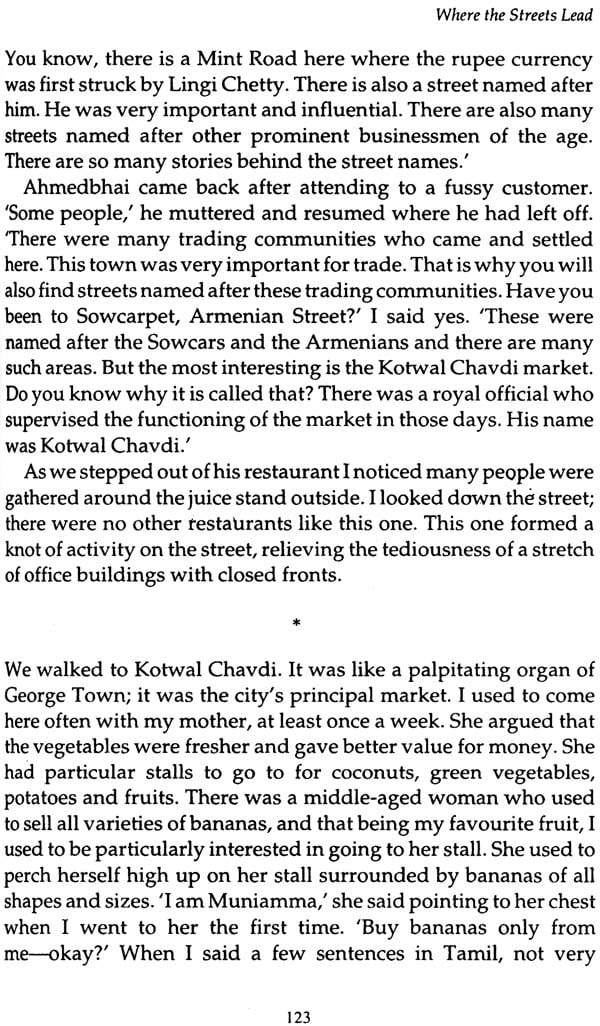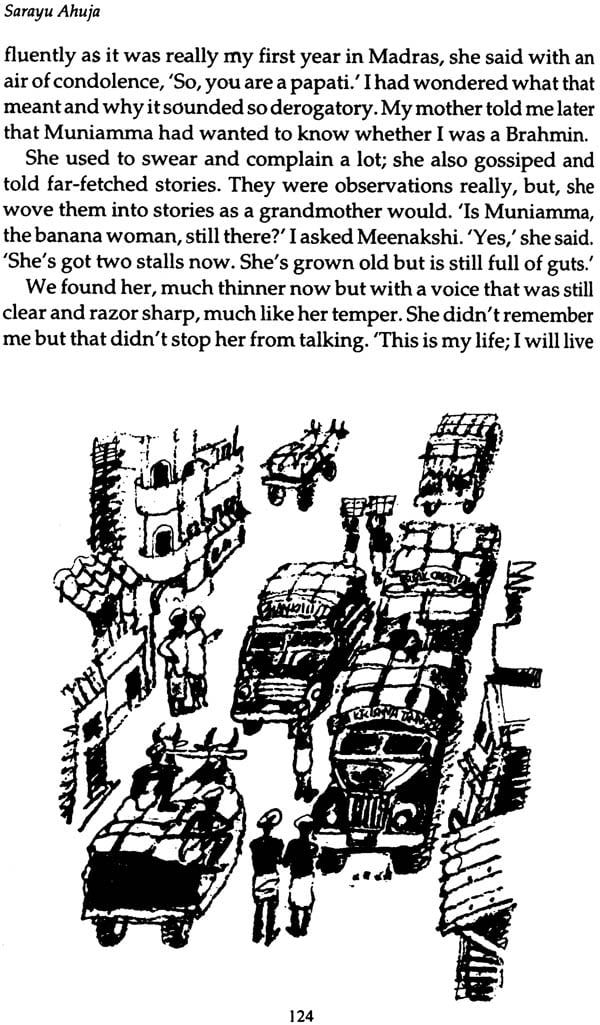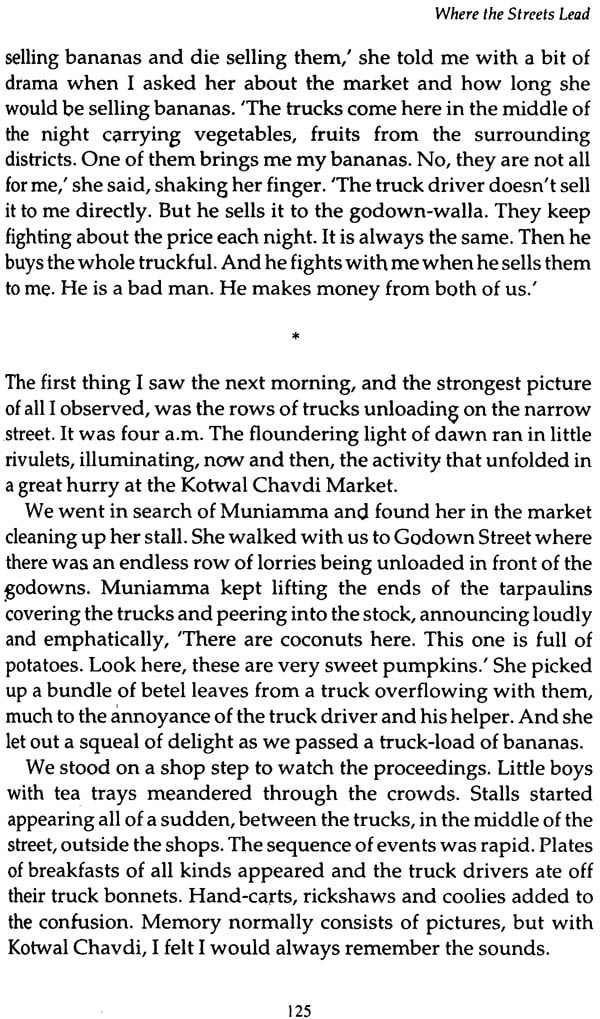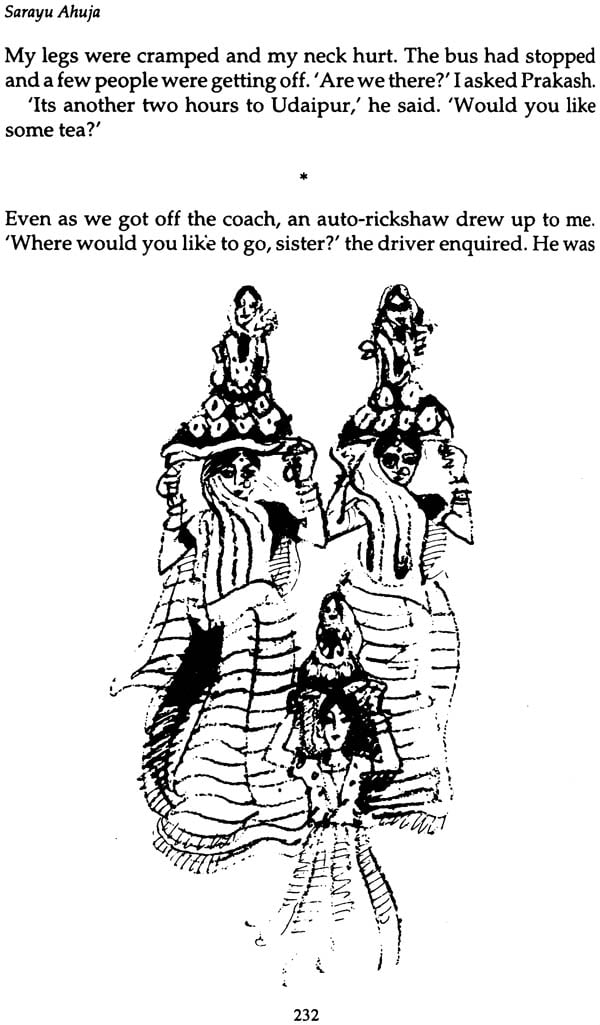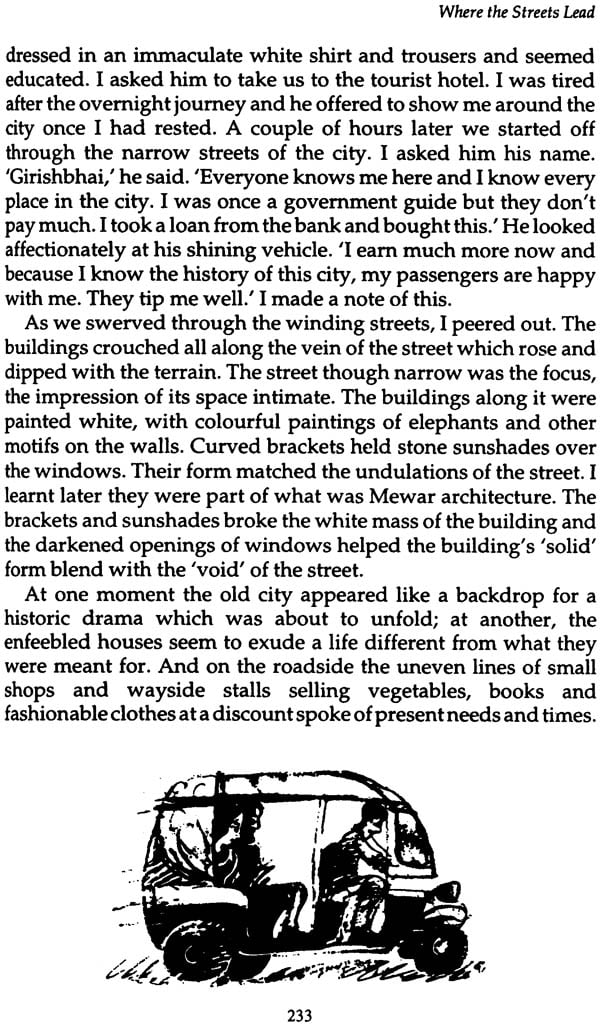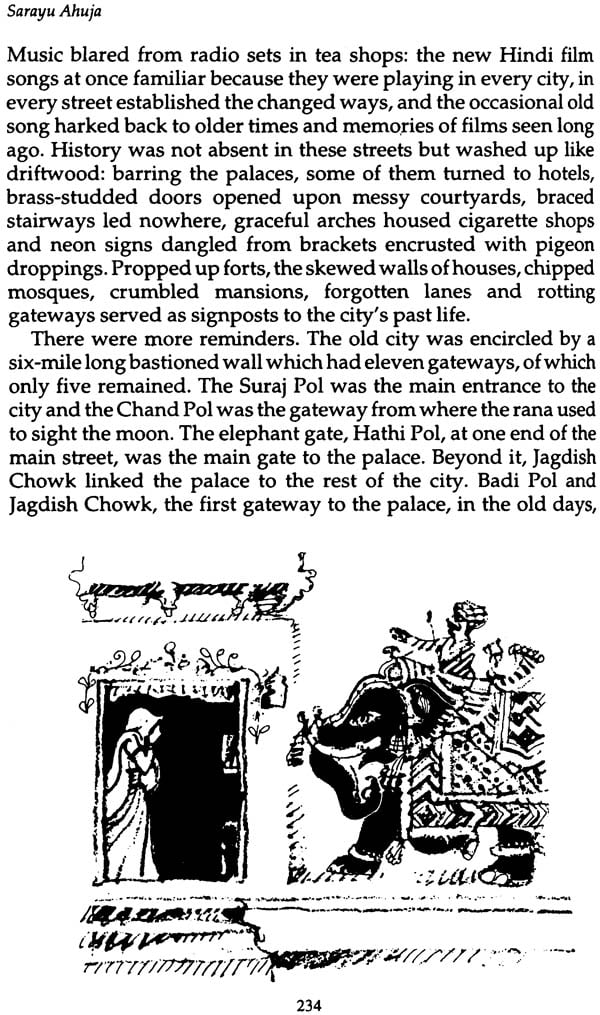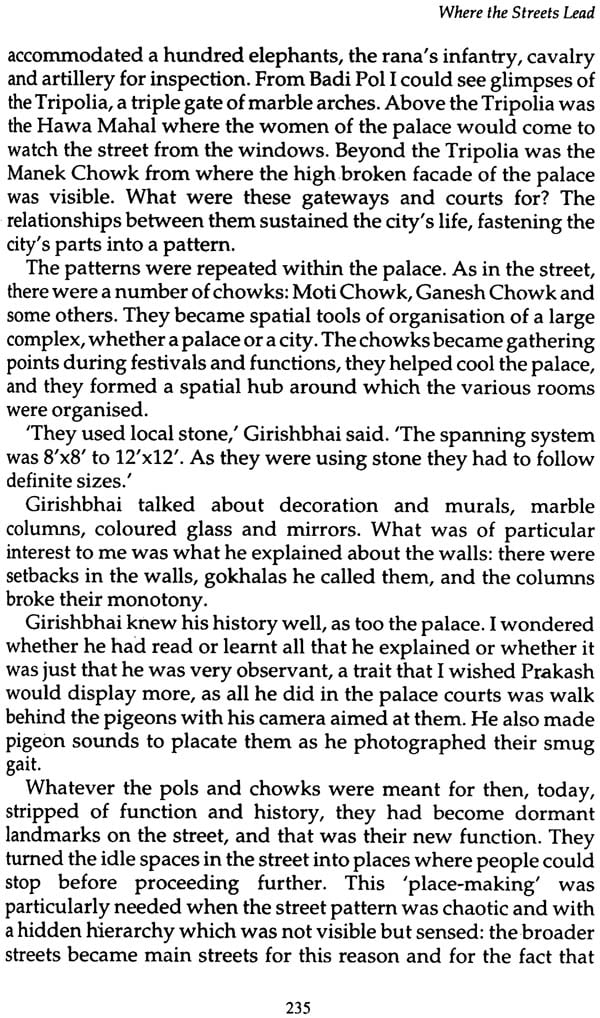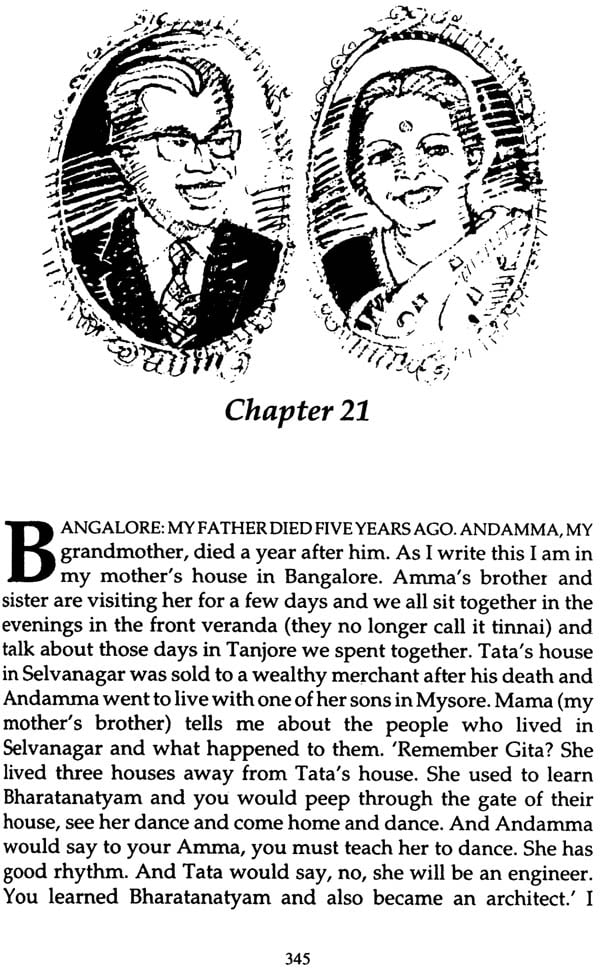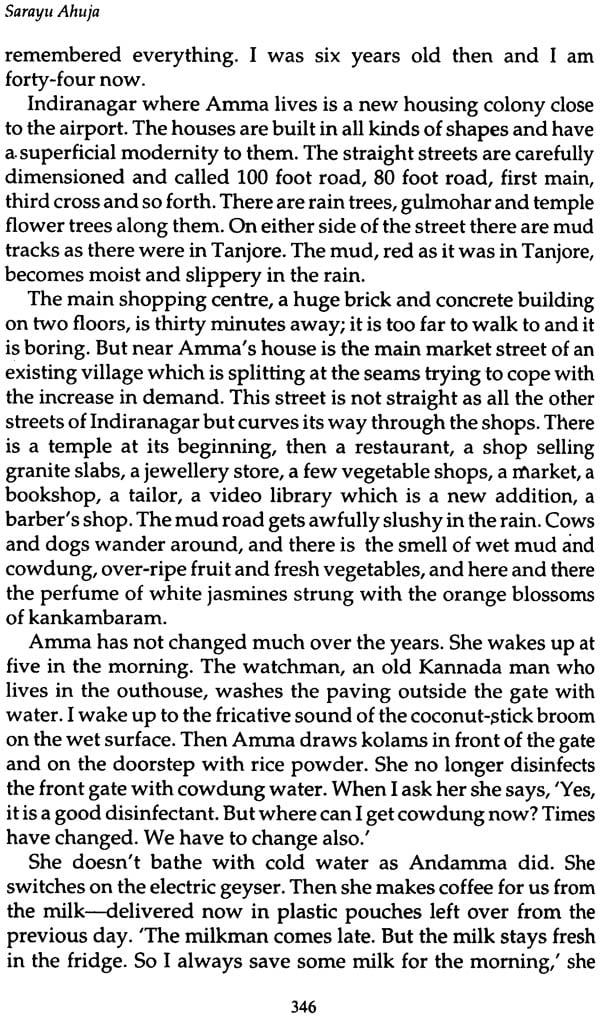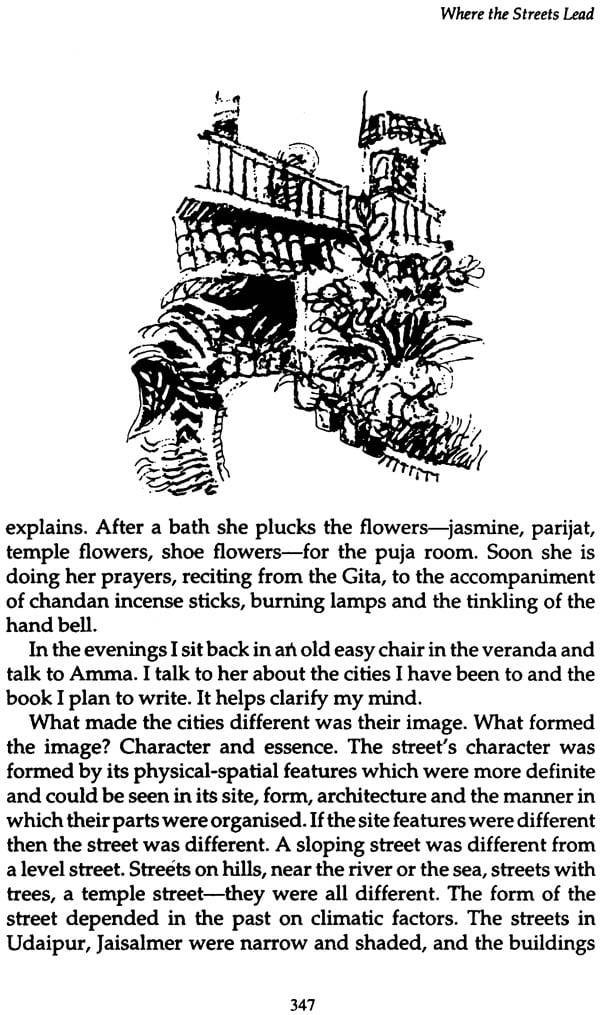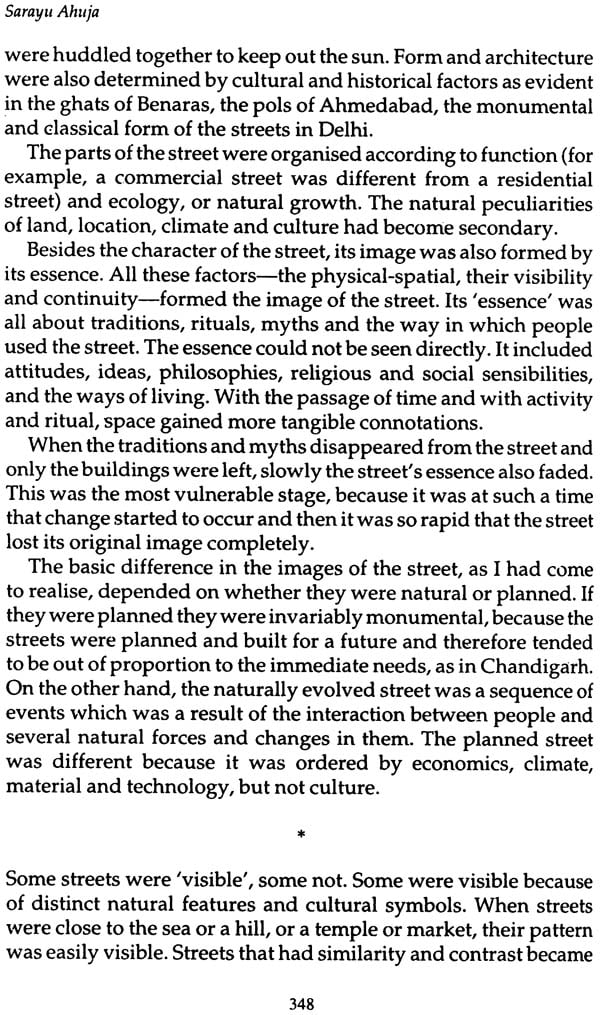
Where The Streets Lead
Book Specification
| Item Code: | NAG453 |
| Author: | Sarayu Ahuja |
| Publisher: | Penguin Books India Pvt. Ltd. |
| Language: | English |
| Edition: | 1997 |
| ISBN: | 9780140259520 |
| Pages: | 384 (Throughout B/W Illustrations) |
| Cover: | Paperback |
| Other Details | 8.5 inch X 5.5 inch |
| Weight | 440 gm |
Book Description
Back of the Book
The secret life of streets
Cities are remembered by their streets, which have a personality all their own. Some are broad and indolent, others brisk and efficient and some resemble courtesans, painted and bright by evening, drab and gritty during the day.
Sarayu Ahuja takes a leisurely stroll through streets in cities as different as Ahmedabad, Jaipur and Mumbai, viewing them not in terms of configuration and design alone but also in the context of their history and their sights, smells, sounds and people. In the process she shows the evolution of a city's individual character. She visits bustling Jaisalmer, suspended like a drop of water over a sea of sand; Chandigarh, grand and imperial; Benaras, intimate and feverish with activity; the lanes of Siddpur, secluded and withdrawn from the public eye, and a host of other cities.
The outcome is a unique study of Indian streets by a professional architect which, besides being an entertaining travelogue, shows us our streets in a new and revelatory light.
About the Author
Sarayu Ahuja trained as an architect and town planner at Madras and Tokyo universities. The evolution and growth of cities, especially those in Asia, has been a focus of her research, and she has written extensively on this and other subjects for newspapers and magazines in India and abroad. She is the editor of Indian Architect and Builder, and recently scripted episodes for a Channel Four television series on major Indian cities. She lives in Mumbai.
Foreword
I first met Sarayu five years ago. She was introduced to me by a mutual friend. She seemed to me unusually intelligent and versatile: she was an architect; she edited an architectural magazine; she lectured; she also wrote somewhat minatory letters to the editors of various national newspapers, mainly on architectural matters.
Some time after we first met, she gave me a book of poems she had written. She knew, as she kept saying, nothing about technique, but these poems seemed to me remarkable. She had a natural ear for the rhythm and texture of language; she also appeared to possess an instinctive wisdom. I told her, not entirely in jest, that these poems were like good translations of the work of some fourth century Tamil poet, a female saint. I began to think of her as a writer.
She explained her interest in streets to me. She also told me of her experiences as she went around India collecting material for a book on its streets. She is a very good conversationalist, with a not always delicate sense of humour, and a great gift of timing. I thought any book she wrote on Indian streets would be very readable, possibly brilliant.
So I asked her to show me a couple of chapters of the book she was working on. She did, and I was amazed. I was amazed that so vital and alive a person could produce anything which was so abysmally dead. All the architects I have met, apart from Buckminster Fuller and Mies Van der Rohe, turned out to be bores when you looked into their minds. I did not think Sarayu was a bore. When she asked me what I thought of her chapters, I told her the truth and I also said, 'Why don't you write as you talk?'
To my amazement she took my advice, and rewrote the entire book. I was amazed all over again by what emerged. She is a natural writer; indeed I am surprised that she did not choose to become one, instead of embarking upon so dreary (and in India so wholly irrelevant) a profession as being an architect.
About the validity of what she says, in a technical way, I know nothing, expect that she is a woman full of common sense, perception, and idiosyncratic ideas, which come through in this book. In the end, it is her talking to the reader, with a clear and unfaltering voice. It is her being herself. To be able to make your own voice heard is one mark of a born writer. She has this rare gift.
I dislike much modern architecture and I do not know anything about it, nor do 1 want to. I have much more interest in ancient monuments, perhaps because I am rapidly turning into one. But if I cannot judge what Sarayu is saying architecturally, I can at least say this-Where the Streets Lead is the only book I have read on an architectural theme which has sustained my interest and made me feel that it is a worthwhile place to which the author is leading me.
Author's Note
This is my first book. There was another, a small book of poems, but that now seems to me a miscarriage. I don't really know why I am so obsessed with streets; it seems to me a fascination that has continued from my childhood days. 'A book about streets? What can you write about streets?' many friends and colleagues queried. They concealed their amusement or perhaps disquietude from me. My obsession continued.
I met Prakash Rao, a photographer and now a friend. He like all the others was wary about the subject of the book. It was probably because he possessed a singular brand of cynicism coupled with a wry sense of humour that he agreed to come with me. He became my travelling companion and sounding board as well as my photographer. He was someone with whom I shared my excitement about the streets, the buildings and people and activity in them, also my idiosyncrasies; he responded enthusiastically. If he wasn't really enthused, then he was a good pretender. I am grateful to him.
I am also indebted to S.K. Sharma who at that time was the Chairman and Managing Director of HUDCO, M.N. Joglekar, Director of Development and Planning of HUDCO, and the institution itself for giving me the financial support to travel to eight cities.
Many friends and relatives helped in their own ways. At the end of a year of travelling and a year of writing, the first manuscript was ready. Monisha Pinto edited it, smoothing all the rough edges. By then nagging doubts had begun to creep in, perhaps inevitable in anyone who is writing a 'first' book. I showed the manuscript to Dom Moraes. He said, 'It's too decorative.' Then he added more reflectively, 'It's too academic. Who is going to read it?' 'Architects and planners,' I replied with confidence. 'Do they habitually read boring books?' he remarked rather sardonically, as is characteristic of him.
It was rather out of being infuriated by someone who I surmised-wrongly, as it turned out-knew little of architecture that I succumbed enough to write two sample chapters for Dorn in a way that he suggested. He liked the chapters written as an autobiographical account; he liked them very much, and fixed up a meeting with David Davidar of Penguin almost immediately. David, after reading the chapters advised me some more. 'Why don't you fictionalize a little?' he said. It is, I firmly believe, as a result of these two hits of pertinent advice that the book has taken an autobiographical, quasi-fictional shape. By quasifictional I mean that some people and events are made up of bits of other people and other events. In its new form it is not a book about architecture alone. It is also about people, how they live, their cities and their streets, the stories they recount. In a sense, therefore, it is essentially about the architecture of the city in every dimension: physically, sociologically, historically and culturally. I thank both Dom and David for moulding the book and me as a writer.
For their help I would like to thank, among many others, R.V. Pandit and Sushil Ansal for their continuous support, and my brother Murthy. I am indebted to Pradeep, who with immense patience taught me to use the computer and solved the bewildering problems I faced juggling with the electronic device. And who spent many hours of many Sundays formatting the manuscript on the computer. Also who understood, many times, and did not, sometimes, my preoccupation with the book. And to Anshu and Ayush, my children who laughed away my irritations which occurred with unshackled frequency. And to my mother in Bangalore whom I ran to in search of solitude, a prerequisite for any form of writing.
My mother, when she had read all the chapters asked, 'If I were to look for the book in a bookshop or a library, in which section would I find it?' Honestly, I had no answer.
Introduction
Some years ago, Sarayu told me about her interest in writing a book about streets. At that time I did not understand what she meant. For she wanted, though herself an architect, to write a book for people who were not. I did not believe this could be done. Then she began to travel through the streets of India and they carried her on her quest.
That quest, that journey, has been like a river for her, always carrying with it all that is around it and at a pace which understands the levels of the ground, the pressures of the wind and the supporting systems, the seasonal variations, velocities, depths, expanses. She comes closer to nature where she eventually finds her answers: in the nature of life, the cycle of growth and in the way people choose to live together. Unconfused by surfaces, she finds the invisible force, a law that brings order and the vulnerability inflicted by change; and in her book one sees the street through the eyes, heart and body as a whole: sociological, psychologically viable, cultural, ritualistic, climatic; even the economic situations, they are all there. Beside them are observations on symmetry, asymmetry, order, chaos, high and low scales, straight and undulating spaces with changing widths, thresholds and connections.
The street is a world where one waits, watches, contemplates, absorbs, transacts, cherishes through generations and history. It is not merely about architecture, engineering, economy; it is to be felt, breathed and absorbed. However, if you try to touch it, hold it, only a fragment will remain. To see the street as a whole one has to be totally sensitive: shed the external self and feel with the inner being so that one can conceive images of one's own choice.
Sarayu has innocence, curiosity and a capacity to absorb with wonder, and her belief in some kind of beauty that must exist and that people unconsciously aspire to impels her to interpret things beyond what they appear. She uses the objects around her, images from her memories and a whole constellation of events, however minute, and finds paths rich, good and wide. In her imagery the tangible becomes intangible, then once again she makes it simple and visible. This I consider a rare quality. In her streets there is nothing that does not seem to have been understood, held, lived, and known in memory's wavering echoes; no experience has been too unimportant, and the smallest events unfold like fate: a wide fabric in which every thread is guided by a weaving hand and placed alongside another thread, the warp and weft of which is supported by a hundred others. There is perhaps an analogy in this book with the growth of life: a tree rises, branches, becomes something which all those living around observe; in this sense the tree is like the street. A tree reaches up to the sky and has its roots in the earth. A tree rises and falls. So eventually does the street.
What Sarayu does in this book, page after page, is to create a picture of the streets of India such as has never been produced before, and, speaking only as an architect, I think of this as a great achievement. Because it is fluid and. ambient and has roots, and her words reach towards the sky.
Contents
| Foreword | ix |
| Author's Note | xi |
| Introduction | xiv |
| PART I | |
| Beginnings | 1 |
| Tanjore | 3 |
| Tokyo | 27 |
| Mumbai | 43 |
| Ahmedabad | 63 |
| Ahmedabad | 77 |
| Single Street | 87 |
| Siddpur | 97 |
| PART II | |
| Connections | 111 |
| Madras | 113 |
| Pondicherrry | 129 |
| Auroville | 143 |
| Goa | 161 |
| Kolhapur | 177 |
| PART III | |
| Journeys | 187 |
| Jaipur | 189 |
| Shekhavati | 213 |
| Udaipur | 227 |
| Jaisalmer | 245 |
| Lucknow | 261 |
| Benaras | 277 |
| Delhi | 295 |
| Chandigarh | 323 |
| PART IV | |
| Destination | 343 |
| Bangalore | 345 |
| Bibliography | 366 |
